The Social Hierarchy of Gorillas Explained
Gorillas are fascinating creatures, known for their strength and intelligence, but their complex social structures are often overlooked. Understanding the social hierarchy of gorillas can provide valuable insights into their behavior, communication, and even their conservation. This article will delve into the various roles within gorilla groups and what makes their social dynamics unique.
The Role of the Silverback
At the top of the social hierarchy is the silverback male, typically the oldest and strongest member of the group. This dominant male not only leads the troop but also plays a crucial role in protecting the group from external threats, such as predators or rival gorilla troops. The silverback’s presence fosters stability and cohesion among the members, as he maintains order and enforces social rules. His strength and experience make him a respected figure, and the group often looks to him for guidance and reassurance.
The Importance of Female Relationships
Gorilla social structures are as much about the females as they are about the silverback. Female gorillas often form strong bonds with one another, creating a supportive network that is essential for raising young and managing group dynamics. These relationships play a pivotal role in a female’s social standing and can influence her access to resources, such as food and mating opportunities. Additionally, a united front among females can help deter challenges from outside males, ensuring the safety and stability of their young.
The Young and Their Progression
Young gorillas experience a unique socialization process as they grow. Initially, they rely heavily on their mothers for support and learning. As they mature, they begin to navigate the social hierarchy, testing boundaries and forging their own relationships. Juvenile gorillas are often playful, which helps them develop vital social skills. Their interactions with both the silverback and other troop members teach them important lessons about cooperation, conflict resolution, and their roles within the group. This gradual progression helps groom future leaders and influences the overall cohesion of the troop.
In Conclusion
The social hierarchy of gorillas is a complex and dynamic system that plays a crucial role in their survival and well-being. From the commanding presence of the silverback to the nurturing relationships among females and the development of young gorillas, each aspect contributes to the strength of the troop. Understanding these dynamics not only enhances our appreciation for these magnificent animals but also underscores the importance of conserving their habitats. If you’re intrigued by gorilla social behaviors, consider exploring more about their habitats and conservation efforts to help protect these incredible creatures.

